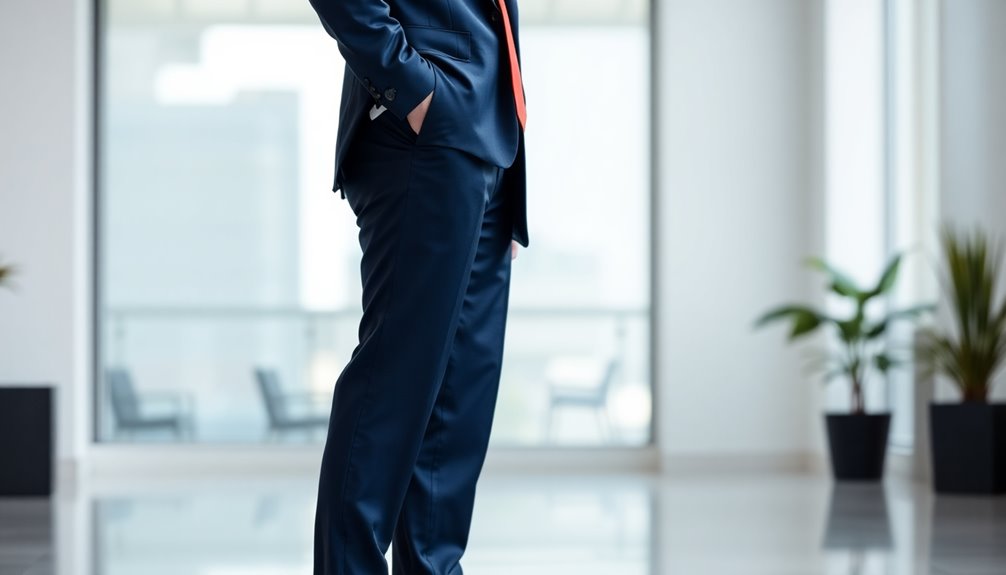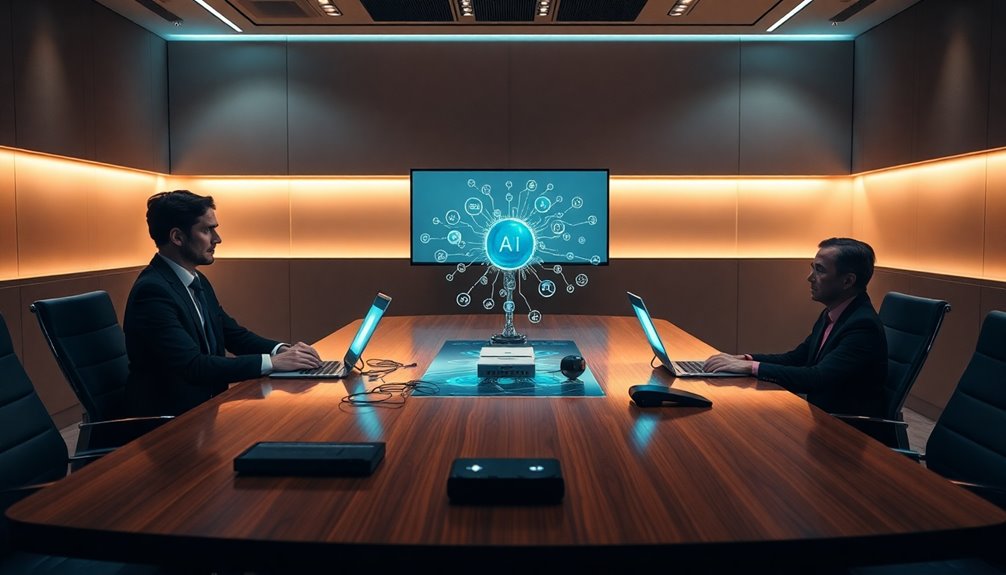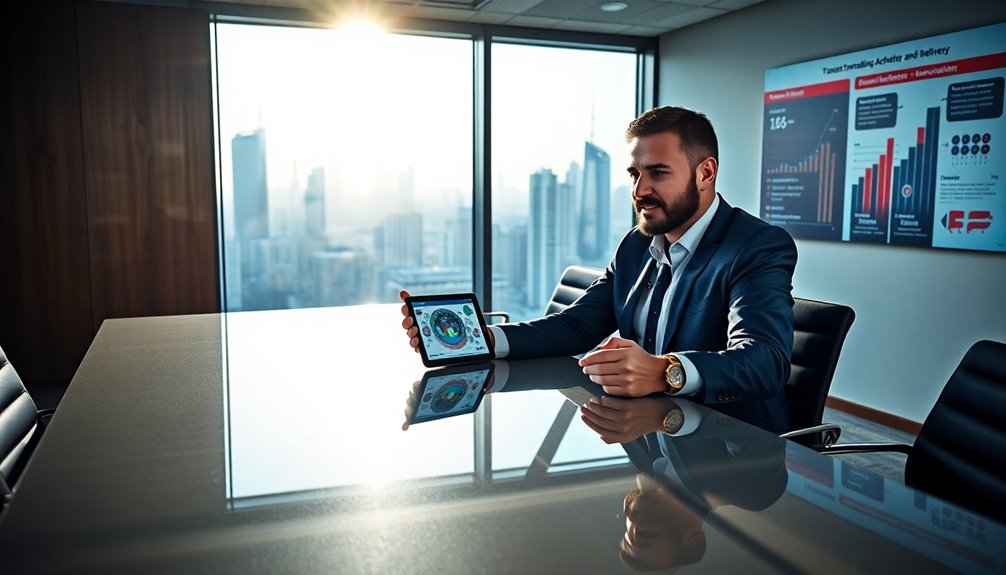The one dress code secret that turns heads in the interview room is dressing one step above what the company typically expects. Research the company culture to understand their attire norms, and then elevate your look. Opt for high-quality fabrics in neutral colors like gray, black, or blue, avoiding anything too loud or casual. Ascertain your outfit is polished, clean, and fits well, making you look both professional and confident. Don't forget the power of subtle, elegant accessories to complete your appearance. Keep these tips in mind, and you'll be ready to shine in that interview room!
Key Takeaways
- Dress one step above the typical company attire to convey professionalism and confidence during interviews.
- Choose high-quality, breathable fabrics in neutral shades to ensure comfort and a polished appearance.
- Pay attention to grooming and accessories; keep them simple and elegant to enhance your overall look.
- Research the company culture to align your outfit with their dress expectations and values.
- Arrive on time and exhibit positive body language to reinforce your professional image alongside your attire.
Understanding Company Culture

Understanding a company's culture is essential when preparing for an interview, as it can greatly influence your wardrobe choices.
Start by researching the company's dress code. You can visit the location to observe how employees dress, giving you firsthand insight into their style. Additionally, check out the company's website photos for visual clues about their attire standards.
Don't hesitate to call the company directly to ask about their dress code; it's a straightforward way to gather information.
Also, browse social media platforms to see what employees share about their outfits. If the company interacts with clients or customers, observe their dress as well, as it might reflect the expected standards.
Recognize that different environments require different approaches: formal settings like finance demand a polished look, while creative or tech environments often embrace a more relaxed style. Understanding the importance of company culture will help you choose an outfit that aligns with their expectations.
Dressing for the Role

When you're preparing for an interview, dressing for success is key.
You need to align your outfit with the company culture while prioritizing professionalism over casualness. This approach not only boosts your confidence but also shows that you understand the role you're aiming for. Understanding company dress code is essential in selecting the right attire that reflects your respect for the organization.
Dress for Success
Dressing for success in an interview means aligning your attire with the role you're aiming for. The right outfit not only boosts your confidence but also shows employers that you understand their expectations.
Whether you're going for a business professional or business casual look, here are some key points to reflect on:
- Business Professional Attire: Choose well-fitting suit jackets, light-colored buttoned shirts, and tailored slacks or skirts. Don't forget a simple tie or scarf if it fits the occasion.
- Business Casual Attire: Opt for clean, neutral slacks or pants paired with a button-down shirt or polo. Avoid jeans, regardless of the company's dress code.
- Fabric and Fit: Wear smooth fabrics that fit well and provide some stretch. Ascertain your clothes are clean, pressed, and modest. Additionally, color psychology indicates that black conveys confidence, which can enhance your overall presentation.
- Grooming: Maintain neat hair, manicured nails, and polished shoes. A light fragrance can add a nice touch.
- Accessories: Choose minimal jewelry that won't distract, and keep makeup natural to enhance your features subtly.
Align With Company Culture
Getting your attire right for an interview can make a significant difference in how you're perceived. To truly align with company culture, you need to research the organization's dress code. Start by exploring their website and social media to get a sense of what current employees wear.
Different industries have distinct expectations; corporate roles often lean formal, while creative sectors might embrace a relaxed vibe. It's important to remember that dressing one step above is a key strategy to show professionalism during your interview. Additionally, understanding the types of custody arrangements in family dynamics can inform how you present yourself, especially if the role involves working with families or children.
Pay attention to the specific role you're applying for. Senior-level positions usually demand more formal attire compared to entry-level jobs. In creative environments, opt for trendy garments that reflect the styles of both employees and clientele.
If possible, visit the company's location to observe firsthand how staff dress or ask your point of contact about dress code expectations.
It's essential to balance comfort and formality. Dress one step above the normal attire to show respect for the opportunity. Guarantee your outfit is clean, wrinkle-free, and fits well to maintain a polished appearance.
Prioritize Professionalism Over Casualness
Prioritizing professionalism over casualness can greatly impact how you're perceived during an interview. Your outfit not only sets the tone but also reflects your respect for the opportunity and the role.
In fact, 52% of senior managers believe how someone dresses is very important. By dressing appropriately, you establish credibility and showcase your seriousness about the position. Additionally, 33% of employees prefer informal dress codes over an additional $5K salary, highlighting the significance of appropriate attire in professional settings.
Here are some key points to keep in mind:
- Understand the industry: Tailor your attire to fit the role and environment—suits for corporate, smart-casual for less formal settings. Embracing a growth mindset can also help you adapt your style to different professional contexts.
- Dress one step up: Aim to be slightly more formal than the company's typical dress code.
- Choose the right fit: Guarantee your clothing is neither too tight nor too loose to maintain a polished appearance.
- Pay attention to details: Clean, pressed clothes and minimal accessories show attention to detail.
- Select appropriate footwear: Opt for real or imitation leather shoes in brown or black tones to complete your look.
Choosing Fabrics and Colors

When preparing for an interview, selecting the right fabrics and colors can greatly impact your confidence and comfort.
Opt for breathable materials that allow you to sit comfortably for extended periods. High-quality fabrics like wool or wool blends are ideal for all-season wear, while smooth textures help you look polished and professional. Researching company dress standards is essential for making appropriate attire choices, as dress code varies by industry and company culture. Additionally, understanding technical SEO can help enhance your online presence, making a strong first impression.
Prioritize comfort by choosing fabrics with some stretch, ensuring you can move freely without distractions.
Fit is essential, too. Well-fitting clothes project confidence, so consider tailored options that enhance your silhouette without being too tight or loose.
Seasonal considerations are important; choose fabrics that suit the weather and the interview setting, ensuring you're comfortable throughout the process.
When it comes to color, neutral shades like gray, black, and blue are safe bets for most industries.
If you're interviewing in a formal environment, stick to conservative colors. For creative roles, don't shy away from slightly more expressive hues, but keep it classy with solid colors or small patterns to avoid distractions.
Finally, research the company culture to align your outfit with their values, dressing one step above the everyday attire to reflect your seriousness and respect for the opportunity.
Avoiding Distracting Clothing
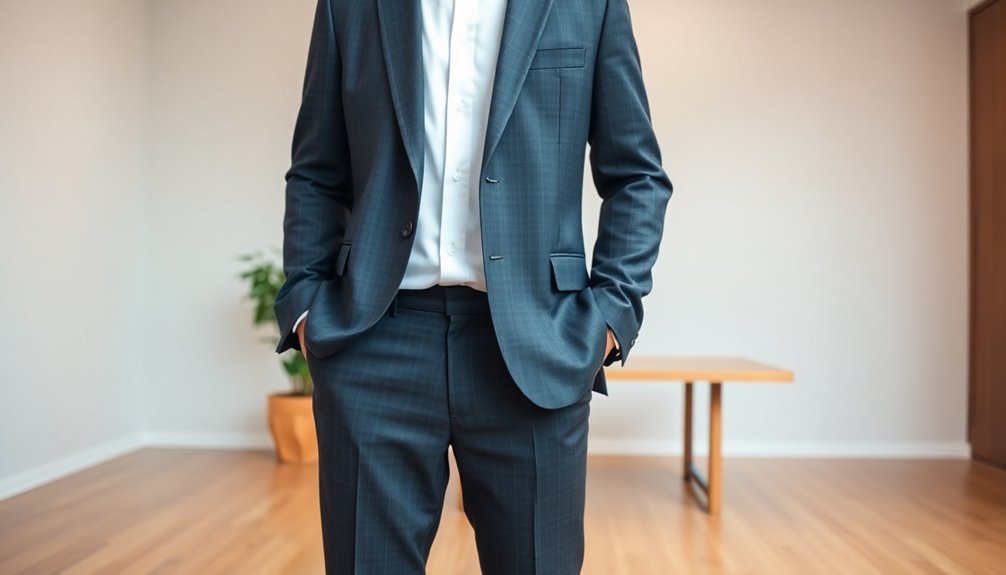
When you're preparing for an interview, choosing subtle patterns is key to maintaining a professional appearance. Limit your accessories and jewelry to avoid drawing attention away from your qualifications. Professional attire can significantly enhance your image and help you make a strong first impression.
Choose Subtle Patterns
Choosing subtle patterns is essential for making a good impression during interviews. When you select your outfit, remember that the goal is to keep the focus on you and your qualifications, not your clothing. Loud prints and large logos can distract interviewers from what really matters. Instead, opt for understated designs and classic patterns that convey professionalism. Additionally, keep in mind that 37% of managers decide against candidates based on attire, so your choice in clothing can significantly impact your chances.
Here are some tips for choosing appropriate patterns:
- Avoid loud, distracting prints and neon colors.
- Stick to solid colors or shirts with small patterns like pinstripes or herringbone.
- Use neutral shades such as navy, charcoal gray, and beige.
- Verify your fabric looks polished and fits well; wrinkled clothing is a no-go.
- Research the company culture to match your outfit's formality to their standards.
Limit Accessories and Jewelry
Keeping accessories and jewelry understated is key to maintaining professionalism in interviews. You want your attire to speak for itself, so opt for simple and elegant pieces. Classic stud earrings, delicate necklaces, or slim bracelets can enhance your outfit without drawing attention away from your qualifications.
Avoid large, flashy, or noisy jewelry, like bangles or dangling earrings, as these distractions can shift focus during the conversation. Subtle jewelry helps to keep the attention on your skills and experience rather than on your accessories.
Make certain your jewelry matches the formality of your attire. For conservative outfits, think classic pearl earrings or a simple watch. If your look is more business-casual, tasteful pendants or bracelets can add a touch of personality.
Research the company culture to ascertain your accessories align with their style; conservative jewelry is best for traditional firms, while creative workplaces may welcome a bit more flair.
Lastly, cleanliness matters. Keep your jewelry in good condition to avoid appearing careless. Skip expensive pieces unless they're wedding bands or engagement rings; they can raise questions about your seriousness toward the job.
Ensuring Comfort and Practicality
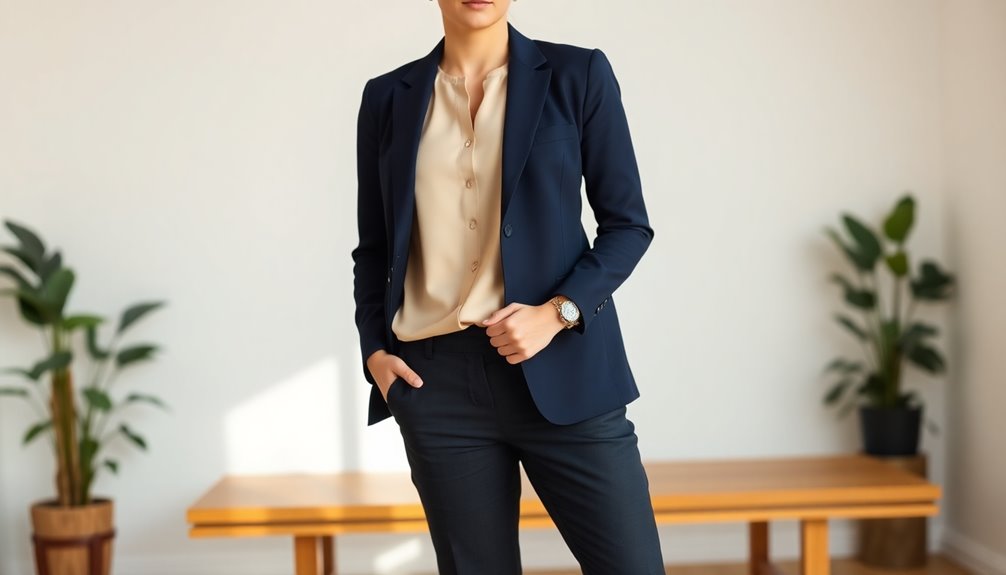
- Choose breathable fabrics: Natural fibers like cotton, wool, or linen can keep you cool and comfortable. Additionally, investing in quality garments can elevate your overall look and professionalism. Selecting materials that are eco-friendly also aligns with sustainable fashion practices.
- Ensure a good fit: Well-fitted clothes look professional and boost your confidence, so avoid anything too loose or tight.
- Dress for the duration: Pick outfits that are comfortable for sitting during long interviews and shoes that are easy to walk in.
- Research the company environment: Tailor your outfit to match the workplace culture, ensuring it's appropriate for the industry.
- Plan for the weather: Adjust your clothing according to the season and environmental conditions to stay comfortable.
Paying Attention to Details

When preparing for an interview, paying attention to details can greatly enhance your overall presentation. Start by verifying your appearance is neat and polished. Check that all buttons are securely sewn on, zippers work smoothly, and there are no loose threads or signs of wear on your clothes.
Polish your shoes until they shine and make certain the hems are even and not fraying.
Choosing appropriate colors and patterns is vital. Opt for neutral colors like black, navy, gray, or beige, and avoid distracting patterns that might divert attention from your qualifications. Stick to conservative colors to maintain a professional image. Different roles may require different styles of dress, so ensure your outfit aligns with the expectations of the position you're applying for.
Inappropriate attire can undermine your efforts. Avoid low-cut, tight-fitting clothing, short skirts, and anything that shows excessive skin. Ripped jeans or casual wear aren't acceptable, even in relaxed work environments.
Lastly, manage your accessories and grooming. Avoid overpowering fragrances, and verify your belt matches your shoes. Wear dark-colored socks that aren't distracting, and opt for lace-up dress shoes instead of loafers.
A professional haircut and clean shave complete the look. By focusing on these details, you'll make a strong impression in the interview room.
The Power of Fit
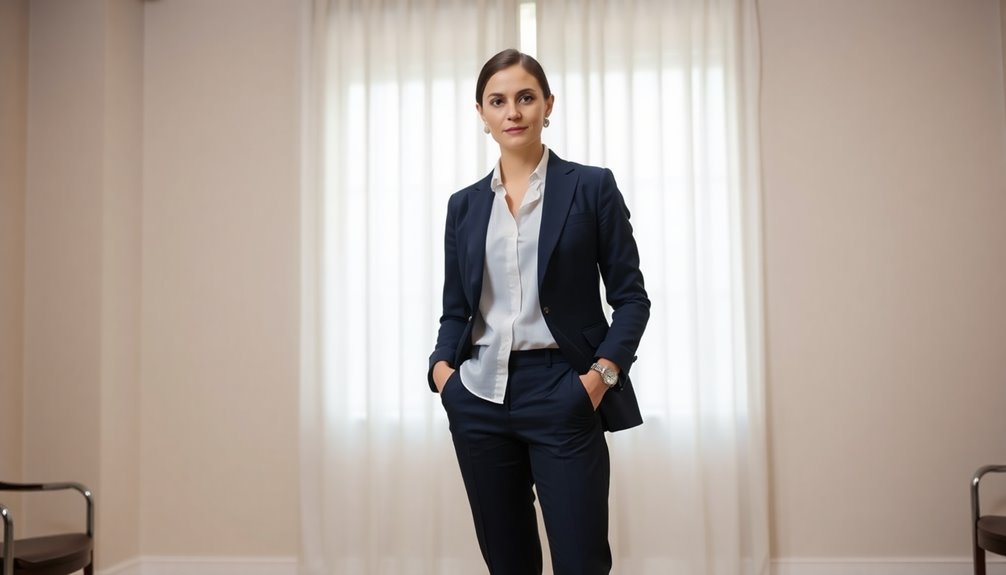
Well-fitting clothes play a significant role in your interview success, as they enhance your overall presentation and contribute to a polished appearance.
When you wear clothes that fit well, you convey professionalism and attention to detail. On the other hand, ill-fitting garments can distract from your qualifications and leave interviewers with a negative impression. Recent survey data indicates that 38% of hiring managers believe suits are necessary for interviews, highlighting the importance of appropriate attire. Additionally, first impressions can be as impactful as gold IRA fees, so aim for that Goldilocks fit—not too tight, not too loose.
To guarantee your outfit makes the right impact, keep these points in mind:
- Clothes should complement your body shape and size.
- Avoid overly casual items like denim or fanny packs.
- Choose polished shoes that fit well; scuffed footwear can undermine your look.
- Limit accessories to maintain a clean, professional appearance.
- Research the company culture to align your outfit accordingly.
Making a Lasting Impression
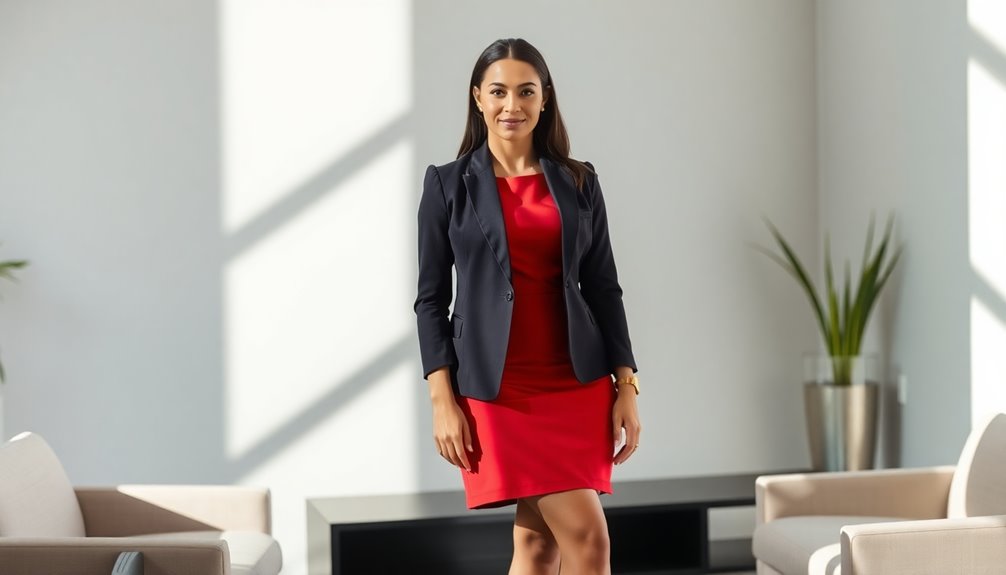
Making a lasting impression during your interview is vital, as it can greatly influence the hiring decision. Start with thorough pre-interview preparation; research the company's profile, core values, and recent ventures. Understand the interviewer and the company culture to tailor your approach. Anticipate common questions and prepare thoughtful inquiries focusing on culture and job expectations using the 4 C's: Connect, Culture, Challenges, and Close.
Your professional attire plays an important role in how you're perceived. Dress in line with the company's dress code; if unsure, lean toward formal business attire. Verify your clothes are clean, fit well, and avoid casual items like shorts or jeans. Keep accessories simple and maintain a polished appearance. Punctuality reflects professionalism, so arrive on time to make a great first impression. Consistently presenting yourself well can help establish your topical authority in the eyes of potential employers.
During the interview, exude confidence without crossing into arrogance. Make eye contact, smile warmly, and engage actively with the interviewer. Use positive body language to express enthusiasm and gratitude for their time.
Close with a positive statement about the opportunity, and follow up with a thank-you note that reaffirms your interest and requests feedback. This combination of preparation, attire, and engagement will help you leave a memorable impression.
Frequently Asked Questions
How Can I Accessorize Without Being Distracting?
To accessorize without being distracting, stick to simple and elegant pieces. Choose classic stud earrings or a delicate necklace that complements your outfit.
Avoid large or noisy jewelry that might divert attention. Make sure your accessories align with the formality of your attire and the company's culture.
Keep everything polished and in good condition, so you project professionalism while still showcasing your personal style. Less is often more in these settings.
What Should I Do if I Don't Own Formal Attire?
If you don't own formal attire, start by researching the company culture to understand their dress code.
Invest in versatile pieces like a blazer or dress in neutral colors that you can mix and match.
Smart casual can also work well, so consider incorporating dressy tops and clean trousers.
If needed, borrow from friends or rent items—just make certain they fit well and are clean.
You'll feel confident and prepared for your interview!
Is It Acceptable to Wear Jeans to an Interview?
Surprisingly, 70% of hiring managers say that a candidate's attire influences their impression during interviews.
While jeans might be acceptable in some industries, it's essential to take into account the company culture first.
For traditional fields, jeans are often too casual.
If you're unsure, lean towards business casual, opting for dark, well-fitted jeans with a polished top.
How Do I Choose the Right Shoes for an Interview?
When choosing the right shoes for an interview, focus on comfort and professionalism.
Opt for heels that don't exceed 4 inches, choosing covered pumps over open-toe styles. If you prefer flats, make certain they're clean and in good condition, sticking to solid colors.
Avoid casual footwear like sneakers and sandals.
Consider the industry and setting to guarantee your shoes match your outfit and project the right impression. A polished look can make a strong impact!
Can I Wear Bright Colors if They Match the Company Logo?
Wearing bright colors that match the company logo might seem like a surefire way to dazzle everyone, but it's not always that simple!
You need to reflect on the company culture first. If it's creative, go for it; if it's more traditional, stick to classic colors. A splash of bright in your accessories can help you stand out without overwhelming your outfit.
Ultimately, confidence is key, so wear what makes you feel great!
Conclusion
You might think that your skills matter more than what you wear, but don't underestimate the impact of your outfit. When you dress thoughtfully for an interview, you show respect for the company and its culture. A polished appearance reinforces your confidence and professionalism, making a memorable impression. So, embrace the power of fit and style to enhance your qualifications. After all, your first chance to shine starts long before you speak a word!
Emmeline is the backbone of our content creation team, bringing complex psychological concepts to life with clarity and empathy. As our Expert Writer, she crafts engaging, insightful articles that guide readers through the intricacies of personality assessments and what they reveal about the human condition. Her passion for psychology and personal development shines through in every piece she writes.
